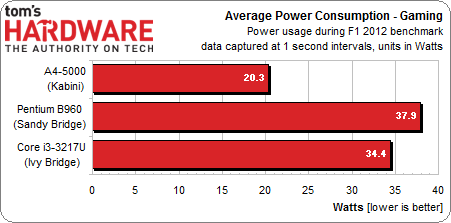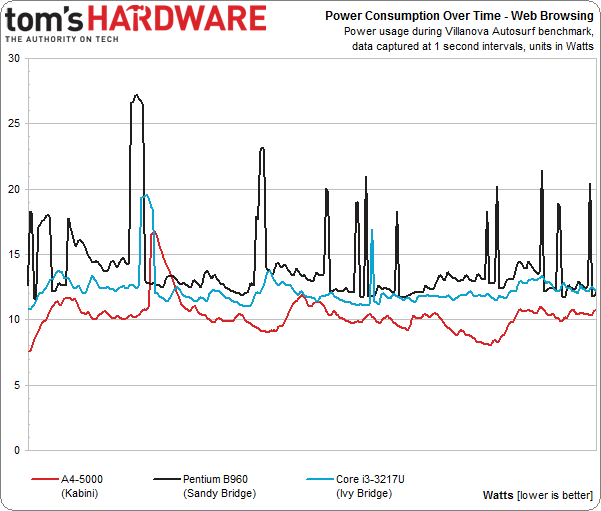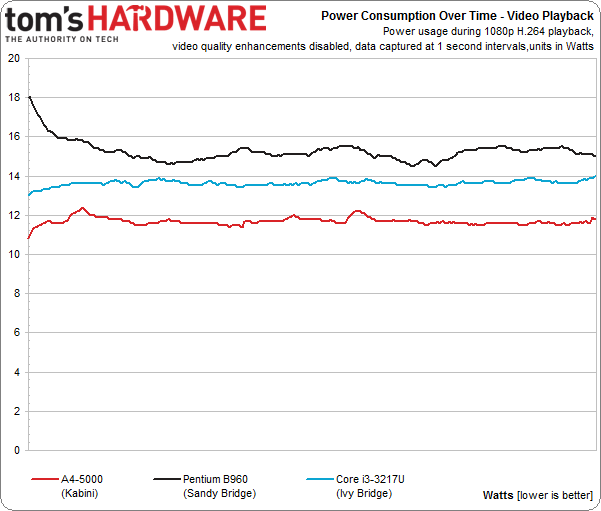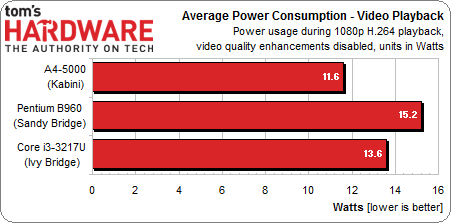AMD's Kabini: Jaguar And GCN Come Together In A 15 W APU
AMD is ready to talk about the Temash and Kabini APUs, based on its Jaguar x86 architecture and Graphics Core Next design. We even have a reference Temash-based notebook here in the lab for benchmarking. How does it compare to Pentium and Core i3?
Power Consumption
AMD's Kabini-based APUs cannot be evaluated based on performance alone. This 15 W processor is meant to go into mobile devices driven by batteries, and lower power use translates to more compact and lighter platforms.
Let's measure consumption in three disciplines: gaming, Web browsing, and HD video playback. The following tests are run by removing each notebook's batteries, plugging them into the wall, and logging power use. In order to factor out each system's LCD, we turn them off and in favor of an external monitor.
Although the A4-5000-based notebook is soundly bested in our F1 2012 benchmark, it also uses a lot less power than the Core i3- and especially the Pentium-based laptop.
The 14 W delta between A4 and Core i3 is particularly notable since the processors driving those platforms have TDPs only 2 W apart.
Web browsing doesn't apply as much of a graphics load, so we're seeing more impact from the x86 cores. The field narrows substantially, but A4-5000 remains the most power-friendly option.
All three of these platforms feature fixed-function logic able to accelerate H.264 playback in hardware. So, the workload isn't much more demanding than simply browsing the Web.
Each solution appears equally adept at offloading the decode process, so we again see the A4-5000 in first place, with Intel's Core i3 just 2 W higher.
Get Tom's Hardware's best news and in-depth reviews, straight to your inbox.
Current page: Power Consumption
Prev Page Results: Compression Next Page The Kabini-Based A4-5000: Mediocre Performance, But Great EfficiencyDon Woligroski was a former senior hardware editor for Tom's Hardware. He has covered a wide range of PC hardware topics, including CPUs, GPUs, system building, and emerging technologies.
-
zeek the geek This is was we expect on the new consoles, I sure as heck can't wait to see what improvements we'll have on games ported over to PC are. I'm tired of these makeshift ports... Glad to see AMD has their hands in the console field, now maybe we'll see a huge influx of cash on their end to help improve their line and drivers that will give Nvidia a good run for so we can see "OUR money" go to good use. To better technology and innovation!Reply -
slomo4sho With Haswell around the corner claiming models with TDP of 15, 13.5, and 10 watts, the lack of performance in this chipset is discouraging to say the least.Reply -
dragonsqrrl This is the best CPU architecture to come out of AMD in a very long time. It has so many things going for it in comparison to the current competition from Atom. Far superior overall performance, improved power consumption and FP performance over its predecessor (weak points of Brazos), much better graphics performance, broader x86 instruction support, and an actual process advantage (28nm vs 32nm). AMD has a huge opportunity here, and I sure hope they capitalize on it quickly because it won't last long. Atom's based on Intel's upcoming Silvermont architecture will likely outperform Jaguar and reverse most of the advantages AMD currently has.Reply -
BringMeAnother Its performing well in all the wrong areas. If I'm going to play games, I'd rather play with at least high settings with decent resolution. I'm perfectly willing to give up mobility for a gaming machine.Reply -
mcx2500 Given that the AMD Temash and Kabinis are priced in the range of Atoms, it is illustrative that the Tom's reviewer used two Pentium and i3 CPUs that cost over $130 and $200 respectively.Reply
To see the Intel chips utilizing dramatically more watts than the Kabini brings up issues discovered by other reviewers. Just look at the graph of the i3-3217u rated at "17 watt TDP" playing F1-2012 at what is 100% or nearly 35 watts! This means that AMD Kabini A6-5200 which is being released in June will outperform Intel's $225+ i3-3217u for price-performance per watt, you can be on it.
While running the range of applications, the AMD Kabini remained cool while the Intel chips heat up dramatically. This heat has to be dissipated from the laptop and it takes a toll on both the machine and user.
HP just announced 10 point touchscreen laptops that utilize AMD Jaguar Kabinis for a breakthrough price of $399 and that is just a start of a flood of good old competition (hello AMD Kaveri APU Xmas). -
dragonsqrrl mcx2500To see the Intel chips utilizing dramatically more watts than the Kabini brings up issues discovered by other reviewers. Just look at the graph of the i3-3217u rated at "17 watt TDP" playing F1-2012 at what is 100% or nearly 35 watts!This is because the i3-3217u is not an SOC, it's just an ULV dual core Ivy Bridge. Many of the controllers and other supporting hardware are located off die on the mother board, which increases power consumption over the CPU/GPU's rated 17W TDP.Reply
Kabini will have to compete with Intel's upcoming ULV Haswell, which will go as low as ~10W TDP and will be an SOC. This is why I said in my previous comment that I feel AMD has a rare advantage right now and a narrow window of opportunity to make an impact. Jaguar will overlap Silvermont on the low end of its TDP range, and Haswell on its upper end. Both will likely outperform it in their given segments. -
cleeve mcx2500Given that the AMD Temash and Kabinis are priced in the range of Atoms, it is illustrative that the Tom's reviewer used two Pentium and i3 CPUs that cost over $130 and $200 respectively.Reply
AMD told us the Kabini laptop they gave us would be priced $500 on the market, and that cheaper versions would be as low as $350.
We used the cheapest comparison laptops we could find. The only thing it illustrates is that we were trying to give Kabini the best chance of strutting its stuff.
-
amdfangirl AMD Kabini follows the idea of a tablet - people buy them because they are good enough. That's what is causing the downturn in the PC industry. With the performance advantage over ARM chips and Intel Atom, I really see this as a viable alternative in netbooks and Windows tablets.Reply
AMD Kabini sleekbook. I am just drooling at the idea of that. -
amdfangirl dragonsqrrl Kabini will have to compete with Intel's upcoming ULV Haswell, which will go as low as ~10W TDP and will be an SOCReply
No, Kabini competes in the Intel Atom price range like its predecessor, AMD Brazos.
Sure they compete in a similar TDP range, but you wouldn't expect people to compare the chips that go into $999 ultrabooks with chips that will (ultimately) go into the same form factor as them, but are priced at <$400.
ULV processors from Intel are priced at a premium - because Intel is unchallenged in that space. AMD would be insane to try and price Kabini anywhere near IVB or Haswell ULV parts, because AMD will never win by overpricing their products.
"There's no such thing as a bad product, just a bad price point"
Edit: Not entirely sure why my comment got cut off, but here it is. Please note this comparison was made about the ultraportable area of the market, where the main concerns are weight, screen size and battery life. If we start comparing a CPU designed for primarily 11.6" or 10.1" screens with say 35W CPUs in a 15" form factor, you've lost the whole point of the comparison you're doing ultraportable vs. desktop replacements. Sure, if a manufacturer wants to put Kabini in a 15" form factor then it's fair game, but for the majority of Kabini chips, we'll see them in ultraportables, not desktop replacements. -
ta152h Comparing Kabini with SB/IB is like comparing a four cylinder car with an eight cylinder car. It's plain silly, and kind of obnoxious.Reply
This was a poor review because of the choice made there. I think a lot people were curious about how improved it was over the Bobcat. No data. How about the Atom? No data. Let's just compare it with chips the Piledriver competes with, instead of those it does. It makes no sense.
In case you guys haven't figured it out, Piledriver is the competitor for SB/IB, not Kabini. Two different markets. That you justify this so poorly by saying one particular notebook would cost x amount of dollars, is borderline insane. From one notebook, which are based on things other than the cost of the processor as well, you would assume all will cost the same? Strange.
The comparisons with SB/IB aren't worthless, but they should have been in addition to the processors in their market, and also with AMD's Trinity line. Maybe four or five processors, instead of just two that are addressing a higher performance market, and architecturally quite close.
You lost this one to other sites. Normally, especially when Chris writes them, Tom's ends up having the best information. Not this time. Not even close.





